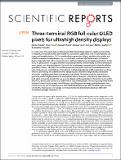Files in this item
Three-terminal RGB full-color OLED pixels for ultrahigh density displays
Item metadata
| dc.contributor.author | Fröbel, Markus | |
| dc.contributor.author | Fries, Felix | |
| dc.contributor.author | Schwab, Tobias | |
| dc.contributor.author | Lenk, Simone | |
| dc.contributor.author | Leo, Karl | |
| dc.contributor.author | Gather, Malte C. | |
| dc.contributor.author | Reineke, Sebastian | |
| dc.date.accessioned | 2018-07-12T12:30:11Z | |
| dc.date.available | 2018-07-12T12:30:11Z | |
| dc.date.issued | 2018-12-01 | |
| dc.identifier | 254680230 | |
| dc.identifier | 67833f5b-2104-41f3-a32f-ed11aed44de0 | |
| dc.identifier | 85049214456 | |
| dc.identifier | 000436233600012 | |
| dc.identifier.citation | Fröbel , M , Fries , F , Schwab , T , Lenk , S , Leo , K , Gather , M C & Reineke , S 2018 , ' Three-terminal RGB full-color OLED pixels for ultrahigh density displays ' , Scientific Reports , vol. 8 , 9684 . https://doi.org/10.1038/s41598-018-27976-z | en |
| dc.identifier.issn | 2045-2322 | |
| dc.identifier.other | ORCID: /0000-0002-4857-5562/work/47136507 | |
| dc.identifier.uri | https://hdl.handle.net/10023/15307 | |
| dc.description.abstract | In recent years, the organic light-emitting diode (OLED) technology has been a rapidly evolving field of research, successfully making the transition to commercial applications such as mobile phones and other small portable devices. OLEDs provide efficient generation of light, excellent color quality, and allow for innovative display designs, e.g., curved shapes, mechanically flexible and/or transparent devices. Especially their self emissive nature is a highly desirable feature for display applications. In this work, we demonstrate an approach for full-color OLED pixels that are fabricated by vertical stacking of a red-, green-, and blue-emitting unit. Each unit can be addressed separately which allows for efficient generation of every color that is accessible by superpositioning the spectra of the individual emission units. Here, we use a combination of time division multiplexing and pulse width modulation to achieve efficient color mixing. The presented device design requires only three independently addressable electrodes, simplifying both fabrication and electrical driving. The device is built in a top-emission geometry, which is highly desirable for display fabrication as the pixel can be directly deposited onto back-plane electronics. Despite the top-emission design and the application of three silver layers within the device, there is only a minor color shift even for large viewing angles. The color space spanned by the three emission sub-units exceeds the sRGB space, providing more saturated green/yellow/red colors. Furthermore, the electrical performance of each individual unit is on par with standard single emission unit OLEDs, showing very low leakage currents and achieving brightness levels above 1000 cd/m2 at moderate voltages of around 3-4 V. | |
| dc.format.extent | 7 | |
| dc.format.extent | 3039908 | |
| dc.language.iso | eng | |
| dc.relation.ispartof | Scientific Reports | en |
| dc.subject | QC Physics | en |
| dc.subject | T Technology | en |
| dc.subject | NDAS | en |
| dc.subject.lcc | QC | en |
| dc.subject.lcc | T | en |
| dc.title | Three-terminal RGB full-color OLED pixels for ultrahigh density displays | en |
| dc.type | Journal article | en |
| dc.contributor.institution | University of St Andrews. Biomedical Sciences Research Complex | en |
| dc.contributor.institution | University of St Andrews. School of Physics and Astronomy | en |
| dc.contributor.institution | University of St Andrews. Organic Semiconductor Centre | en |
| dc.identifier.doi | 10.1038/s41598-018-27976-z | |
| dc.description.status | Peer reviewed | en |
This item appears in the following Collection(s)
Items in the St Andrews Research Repository are protected by copyright, with all rights reserved, unless otherwise indicated.

